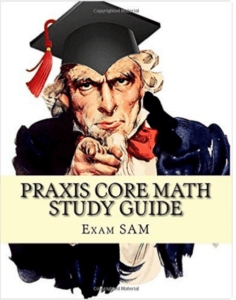We’ve compiled our collection of the best Praxis Study Guide reviews for the Praxis Core. Click on one of the 7 links below to jump to our reviews of some of the most recognized Praxis books.
- Praxis Core for Dummies
- Exam Sam’s Praxis Core Study Guides
- Kaplan – Praxis
- Research & Education Association: Praxis Core
- Praxis Official Guide
- Praxis I Math: My Private Tutor
- Learning Express Praxis Core Academic Skills for Eduators
Praxis Core for Dummies
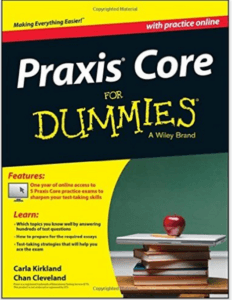
The “_____ for Dummies” is a broadly successful book series covering an astonishing range of topics. Their contribution to preparation for Praxis is Praxis Core for Dummies. This book comes with 5 Praxis Core practice exams online. In a brief Part I, the book gives introductory material and an overview of the test. Unlike some other Praxis prep books, this book is entirely up-to-date and aware of the question formats on the current test. Parts II, III, and IV go through the three subject areas and Part IV contains two full practice tests, each with all three subject sections. Part IV is an intriguing section with “top errors to avoid” in the various subjects. I will analyze the book by subject area.
Praxis Core for Dummies on Math
Holy mackerel! The math in this book is HARD, much harder than you need to know for Praxis Core. The review of math concepts in Part II covers several topics that are beyond anything you need to know for the Praxis Core. If you are planning to teach high school math, and want to review math well beyond the Praxis Core Mathematics Test, then this section might be of interest to you, although you probably know most of this already. BUT, if math is not your favorite thing, and you just want to review the basics so you can get through the Praxis Core Mathematics Test, this is definitely NOT the book for you. The math problems on the practice tests in Part IV were also much harder, with bigger and more complicated numbers to calculate. I will say that I am able to do a great deal of math in my head without a calculator: for example, when I went through the online Praxis Core Mathematics Test released by ETS, I didn’t need a calculator once. By contrast, for the practice tests in this book, I would need a calculator for 1/3 to 1/2 of all the problems! That’s very different from the standards that ETS is maintaining!
Curiously, although this book is up-to-date in other respects, they seem wholly unaware of the alternate question formats in math: the Multiple Answer and Numerical Entry questions. Both math practice tests just had 56 ordinary Multiple Choice questions!
I will mention that a few of the “Ten Common Math Errors to Avoid” in Part VI are worthwhile: this is probably the most Praxis-appropriate math in the entire volume.
Praxis Core for Dummies on Reading
There is a curious disjuncture between what these folks say about Reading in Part III and the practice Reading tests in Part V. In Part III, they correctly say that short passages are about 100 words in length, and long passages are in the neighborhood of 200 words, which indeed reflects the Praxis passages. But then, on the practice Reading tests in Part V, they give monster-length passages, one almost 500 words long, more than twice the appropriate length! They create realistic expectations in Part III but then frustrate those expectations in Part V. The passages on Practice Test One are also odd: three different passages on Shakespeare?? To be clear, I absolutely love Shakespeare, but I think three passages about him is too much. In general, the passage on the ETS online Praxis draw mostly from science and history, whereas the majority of the Reading passages in this book have a decidedly literary bent. Again, I am big fan of passages about Arthur Rimbaud (1854-1891) and John Locke (1632 – 1704) and Jean-Paul Sartre (1905 – 1980), but such passages are not really representative of what you will see on the real Praxis test.
Most of Part III consists of strategies to use on question types. I would describe this section as adequate. Yes, they make a few worthwhile points about studying for Reading. Nothing wowed me as extraordinary, and nothing leapt out as egregious. This is an OK description of the strategies for Reading. Unfortunately, Part V does not provide the most representative passages on which to practice.
Praxis Core for Dummies on Writing
The Writing section in Part IV is curious. First, they give an explanation for writing the essays, but their one-size-fits-all strategy seems more keyed to the Argumentative Essay, not to the Informative/Explanatory essay, in which you compare two different prompts discussing the same basic issue.
Their section on grammar is adequate: again, not the best, not the worst. They don’t cover ever last detail, but for someone starting from Square One in their understanding of grammar, this chapter on grammar could be a good place to start.
In the brief final chapter of Part IV, they correctly enumerate the four types of questions found on the Praxis Core Writing Exam. So far, so good.
What’s most enigmatic is the sheer disconnect between what they say in Part IV and what we see on the practice Writing tests in Part V. There is a whole other question format, giving five versions of a full sentence, that is entirely their own creation. This question format does not appear on the Praxis, and yet, their practice Praxis Writing test has questions of this format. Very confusing! The passages for revisions-in-contents are extremely difficult, which unnecessarily adds to the difficulty of the associated questions; on the Praxis test, the passages accompanying the revisions-in-context tend to be far more approachable. On the Usage questions, their underlying scheme is unclear and ambiguous, unlike the precise underlining that ETS does. Finally, the level of the Research Skills questions were appropriate for someone doing a dissertation in research methods: they didn’t review any of the Research Skills information in Part IV, yet they expect the student to know every last detail about it on the practice test!
Summary
This book is a mixed bag. Here are the results.
Pros:
- This book provides some solid information on basic reading strategies, writing the first essay, the fundamental grammar rules, and the question formats on the Writing test.
Cons:
- The math in this book is absurdly hard, much harder than the Praxis student needs to know.
- The passages on the practice Reading test are too long and too fixated on literature.
- The practice Writing test contains a non-Praxis question format, passages for Revision-in-Context that are too hard, and off-the-chart questions about Research Skills.
The fact that someone who is just starting could derive some benefit from the advice in Parts III and IV is precisely what saves this book from abysmal failure.
Grade: D+
Exam Sam’s Praxis Core Study Guides
This is a review of two books, Exam SAM’s Praxis Core Math Study Guide and Exam SAM’s Reading & Writing Practice Tests. The first book has one “practice exam” in the form of a workbook, in which the authors break everything into individual subjects and explain each subject one at a time. Then, it has two full practice Core Math tests at the back, with explanations. The second book presents two practice Core Reading test with explanations, then some review of grammar and other Writing topics, then two practice Core Writing tests. I will review all this material by topic.
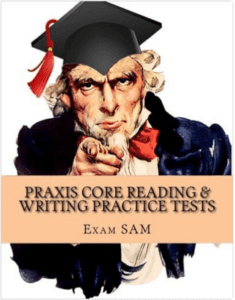
This is irrelevant to the value of what’s inside the books, but I was charmed by their logo, the image of Uncle Sam from J.J. Flagg’s famous 1917 WWI recruiting poster wearing a mortarboard cap and pointing sternly at the reader.
Exam SAM on Math
The math questions in the Core Math Study Guide are clearly patterned on the Praxis Core Math. There is a subtle difference between imitation and emulation. Exam SAM clearly gets the general pattern, and more than half the math questions in this guide are spot-on like the Praxis. Some questions, though, have the outer form but lack the elegance of ETS questions. Also, some questions delve into advanced topics way beyond what the Praxis Math Core would ask. Finally, some of the explanations are less than completely thorough. This volume would not be the best place to try to learn the math if you are starting from Square One; it’s much better for the student who has the gist of the basics and needs reminders as she practices.
I would say that, for the most part, this book would provide good practice for the Praxis Core Math, especially for someone who has a grasp of the basics and just wants more practice problems. The caveat is that a few of the questions will be way too hard, out of bounds for Praxis topics. If you know this, then you can simply ignore those few impossibly difficult questions.
Finally, I will say: one criticism I have all the questions on all three practice tests are organized by general topic, Number and Quantity questions together, then Algebra and Functions questions together, then Geometry questions, then Statistics and Probability questions. This is not realistic. The questions on the Praxis Core Mathematics Test are completely mixed by topic. If question #16 is a Geometry question, then question #17 could be a Statistics and Probability question. It’s very important to do as much practice in mixed subject format, to master the “switching gears” mentality of the test. If you do a whole practice test from this book in one sitting, this organization scheme on these tests wouldn’t matter too much, but this situation underscores the importance of having more practice sources than just Exam SAM.
Exam SAM on Reading
This is tricky. It is undeniable that Exam SAM follows general format of the Reading Exam—the correct distribution of number of questions per passage, the lengths and general subject distributions of the passages, etc. On the surface, they have constructed two practice tests that are very much like the Praxis Reading Test. I will point out that each test contains 56 ordinary multiple choice questions, no multiple answer questions.
I would say that half to two-thirds of the questions are clear and unambiguous questions. Some of the questions, though, are not quite as “clean” as the questions written by ETS. On the Praxis Reading Test, for each multiple choice question, there is one unambiguously right answer and four unambiguously wrong answers. For some of the Exam Sam questions, some of the wrong answers are too tempting, and some of the explanations for why one answer is better than another are unconvincing. These are questions that obviously have not been through any kind of statistical analysis to measure their validity. ETS and Magoosh both use advanced statistical means to monitor question quality: this is a time-consuming process, and these Exam SAM questions clearly have not been through it.
Where does that leave the Praxis test taker with respect to Exam SAM? For a stronger student, I would say, go ahead, use Exam SAM for Reading practice. Many of the questions are just fine, and some are a little harder, a little trickier, than you will see on the test. If you are comfortable with this practice, the real Praxis Reading will seem easy.
Exam SAM on Writing
As with the other sections, if you have to learn from Square One, this is not the Praxis book for you, but if you know the basics and are looking for a brief refresher and practice problems, this is more promising. This book devotes a single page of bullet points to essay strategies—great for someone who is already a talented writer, but not helpful at all to someone who needs to build writing skills.
Exam Sam covers all of grammar and usage in a 12-page whirlwind. This is not comprehensive, and not even all that detailed for someone who is trying to learn grammar. For folks already comfortable with the topic, the brief reminders could provide a refresher. The four pages on research skills is covers most of the basics one needs to know for these questions.
Some of the questions are a mixed bag. About half of them are solid—good Praxis Core Writing practice questions. Many of the grammatical choices in the Usage & Sentence Corrections questions I found debatable, and in some of the Sentence Corrections questions, there were grammatical mistakes in the non-underlined sections. Also, 40 questions on each practice Writing test are multiple choice: no multiple answer questions.
If you are good at the Writing section and looking for more practice, I would recommend the Exam SAM Writing material for further practice, but know that you may be frustrated by some wonky questions. For someone just learning and uncertain about grammar, this volume does not provide enough instruction, and the variable question quality could be confusing. I would not recommend this book for some struggling with Praxis Writing.
Summary
As you probably noticed, some themes have emerged over the three subjects.
Pros:
- In all three subjects, some of the practice questions are good, and would be helpful providing further practice to someone already comfortable with the subjects.
Cons:
- All three subjects have some questions that are not Praxis-like.
- This book could be confusing for someone learning any subject from Square One.
It would be problematic for someone to use these books as his only source of preparation for the Praxis.
Grade: C+
Kaplan Praxis: Proven Strategies to Help You Pass the Test
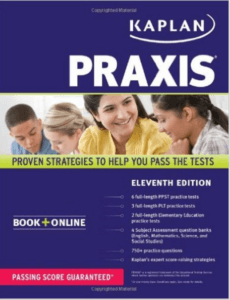
Kaplan is in many ways the great-granddaddy of the entire test prep field, and as you may know, they are ready to offer you preparation for just about every standardized test on the planet. Their contribution to the Praxis exam is Kaplan Praxis: Proven Strategies to Help You Pass the Test. Section One of the book reviews the content of the three core areas. Section Two presents six practice tests, two of each core area. The later sections of the books concern the Praxis II and beyond: this review will only consider material relevant to the three Core tests.
The first problem is that this 11th edition, published in 2013, is still talking about the PPST, the old name for the Core test. This problem is just the tip of the iceberg with this book. I will analyze the book by the three Core areas.
Kaplan on Reading
Experience has many good qualities, but one of the flaws of experience is preventing folks from seeing what is new and different. Just about every standardized test on the planet has a reading comprehension (RC) section, and for most of these tests (SAT, ACT, GRE, GMAT, LSAT, etc.) the passages are sizeable monsters, up to 500 words. Long passage of that sort require certain skills, and Kaplan has a lot to say about those skills—and says it in Section One. On the Praxis, most of the reading passages are single paragraph, only around 100 words. The entire discussion of reading in Section One is not relevant for most of the questions on the Core Reading. It’s as if they copied and pasted the RC section from some other exam, GRE or GMAT, and have just blithely assumed that the same strategies would be relevant on the very different Praxis Reading test.
By contrast, the passage lengths on the two Reading practices tests in Section Two of this book are quite similar to those of the Core Reading: mostly short passages, with a handful of longer passages. The question quality in this Kaplan book is not so good. Some of the practice Reading questions are not bad, but others are imprecise, ambiguous, or debatable in their answers. The quality is inconsistent. By contrast, ETS questions are exemplary in their logical precision. Furthermore, Kaplan does not appear to be familiar with the question types on the Core Reading and nature of the subject matter that ETS generally uses on the Praxis. Kaplan loves questions about author’s tone and possible titles of the passage, and these are rare on Praxis; by contrast, the vocabulary-in-context questions that are common on the Praxis are almost absent in Kaplan. With their decades of test prep experience, the folks at Kaplan are guilty of assuming that the Praxis Core Reading test is conveniently similar to all the other RC sections of other tests, and in drawing on this extensive knowledge of other tests, they have grossly overlooked what is unique and distinctive about the Praxis Core Reading test.
Kaplan on Mathematics
What was true for Reading is true in spades on Math. Here, Kaplan is not at all familiar with the qualities of the Praxis Core Mathematics test. It’s as if they copied and pasted their math section from some other test, the SAT or GRE, and simply assumed that it was equally valid here. Many of the questions are much harder, much trickier, then anything you are likely to see on the Praxis. If you want to push yourself and do much harder problems that you will need to know, by all means, be my guest! But if you struggle with math already, and need to work your way up to Praxis-appropriate problems, then this book would not be helpful for you: you will wind up banging your head against unnecessarily challenging problems, and this could cause your budding confidence to founder.
Finally, this Kaplan Math section makes no mention of Multiple Answer or Numeric Entry questions formats, and it is absolutely agnostic on the subject of whether a calculator is allowed on Praxis. This section will not prepare you well for the current Praxis Core Mathematics test.
Kaplan on Writing
The pattern continues! As you may or may not know, there’s another standardized test called the GMAT: it’s the test that folks take for business school admissions, folks who hope to have an MBA someday. That test has a difficult question type called Sentence Correction. These GMAT SC questions are way way harder than anything on the Praxis. For example, in some of the harder GMAT SC questions, the entire sentence is underlined, but this never happens on the Praxis Sentence Correction questions. The fact that Kaplan has example sentences with the entire sentence underlined tells me that they are drawing more on their GMAT experience in Verbal than on what is unique and different about the Praxis Writing section. The questions here are much harder, much more intricate and tricky, than the questions on the Praxis.
Furthermore, this Kaplan books knows only about the Usage Questions and the Sentence Correction questions. It doesn’t know about the Revision in Context and Research Skills questions. It knows about the Argument Essay but not about the Informative/Explanatory Essay. This section is out-of-date, preparing you for only half the Writing test, and the half that is discusses is more germane to a test you are not taking than it is to the Praxis. This will not prepare you well for the Praxis Core Writing test.
Summary
One of my favorite poets said
There is, it seems to us,
At best, only a limited value
In the knowledge derived from experience.
The knowledge imposes a pattern, and falsifies,
For the pattern is new in every moment
And every moment is a new and shocking
Valuation of all we have been. — T.S. Eliot (1888 – 1965), Four Quartets, “East Coker”, ii
Mr. Eliot’s concern, the role of life-experience in shaping one’s ongoing perspective in life, is a larger question, but in the very specific context of test preparation, experience is not helpful if the teacher confuses the newer test for an old one. This is precisely what has happened throughout this Kaplan book, among other problems. A company with decades of test prep experience has managed to turn this very experience into not an asset but a liability.
Grade: F
REA Praxis Core

The test prep company Research & Education Association, known by the anagram REA, has a good review guide for the Praxis, the Praxis Core: Reading, Writing, Mathematics. Unlike so many of the books on the market, this REA volume, published in 2015, is 100% up-to-date. This book is well-informed about all the changes that have been made to the Praxis exam in the last five years, and it discusses all the question formats that you will see on your Praxis exam.
This REA volume is designed to prepare you for the three Praxis Core exams. Other REA volumes prepare you for some of the other Praxis exams. I will review this volume in the three subject areas.
REA on Mathematics
More than a third of this entire volume is devoted to a review of math skills. This can be particularly helpful to folks who haven’t touch math in a while and are a little intimidated by it. I will say, though, that even those highly proficient in math could benefit from at least perusing this section. This section starts at Square One and goes through all the concepts in depth, with review problems immediately after each group of new concepts. I particularly like the way they will give a problem, and then contrast a “good solution” (typically, the formulaic and standard way of approaching the problem) with a “better solution” (an insight-based solution that is considerably more efficient). In other words, the “good solution” reflects how someone who just knows the basic rules might do the problem, and the “better solution,” as well as the occasional “best solution,” shows more how a mathematician might think about this problem. Through this, the book demonstrates what I might call deep mathematical thinking, and by this constant exposure, there is a good chance that a diligent student might absorb at least some of the habits of mind inherent in mathematical thinking.
This book discusses all the question formats: multiple choice, multiple answer, and numeric entry. This book discusses the on-screen calculator and appropriately warns against its overuse. Overall, this Praxis study guide provides high-quality preparation for the current Praxis Core test.
My only criticism concerns some of the practice problems, both in the Part II Math Review and in the practice tests at the back. A few of the questions are logically sloppy, not as rigorous and precise as the questions from ETS. In a couple cases, the answers were out-and-out wrong. Some of this might simply be flaws in REA’s proofreading process, not any indication of a lack of understanding of the Praxis Core Mathematics test. Nevertheless, it’s important to keep in mind, as you work through these problems: most of them are very good, but they are not all perfect.
REA on Reading
I was very impressed with the intelligent analysis given in Part III on Reading. For someone who has struggled with issues of reading and what to get from reading, a care study of Part III could be invaluable. The discussion of the varied skills needed in Praxis Reading was quite thoughtful, and well supported with example passages and questions. This book definitely shows a keen understanding for what is unique about the Praxis Reading section, and how it differs significantly from the “Reading Comprehension” section of other exams (SAT, ACT, GRE, GMAT, LSAT, etc.) This book has a mix of passages of the appropriate lengths and it pursues questions formats and topics that the test pursues.
My criticism is about a relatively idiosyncratic feature of the passages chosen. Most of the Reading passages are direct quotations from famous writers (e.g. Dr. Martin Luther King Jr., Edgar Allen Poe, W. E. B DuBois, Malcolm Gladwell, Ray Bradbury, etc.) Now, mind you, I have a high opinion of these folks, but the Praxis Reading in particular and ETS in general tend to avoid direct quotes. The ETS Reading passages are artful summaries of important and complex issues, and these are difficult to create. Rather than creating such passages, the REA authors simply lifted quotes from famous writers: as a result, I don’t think the REA Reading practice test have exactly the feel of the real Praxis Reading Test. Apart from this particular issue, the REA questions are of high quality.
REA on Writing
Once again, this book is well informed about the entire Praxis Writing test, the four question formats and the two essays. The book gives a thorough introduction to the two essays, along with a number of very good suggestions about organizing an essay.
After a single chapter on the essay, the book dives into a review of all grammar and related issues. It starts with Capitalization and Punctuation: the latter as a choice for an opening topic struck me as odd, because many of the issues involving the correct use of punctuation requires a knowledge of grammatical topics (e.g. clauses) discussed later. Overall, the discussion of grammar is thorough and quite helpful for the Praxis Writing section. The book has a good list of commonly confused words. Practice exercises immediately follow each bank of concepts.
After discussing all the issues that arise in Usage and Sentence Correction questions, the book briefly discusses issue in Revision in Context questions as well as Research Strategies.
The practice questions in Part IV are designed to test individual concepts, so these questions don’t necessarily adhere to the formal question formats. The book provides questions that rigorously follow the official question format in the practice tests at the end. Overall, the questions in the two practice Writing tests at the end of the book are superb, and students would get a great deal of value from working through these and studying them thoroughly.
Summary
There is a great deal that is quite positive about this Praxis study guide as a means of preparation for the Praxis tests, but as noted above, the book contains a few small issues.
Pro
- High quality instruction in all three subject areas
- Very good practice questions of all correct formats
Con
- A few imprecise or incorrect math questions
- Reading passages quoted verbatim from famous authors
Grade: A–
Praxis Official Guide
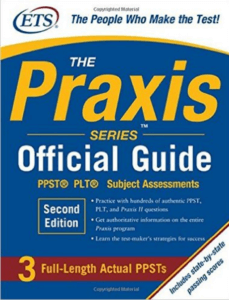
If you want to learn any standardized test, of course, one excellent way is to study the questions released by the folks who write the test itself, and these are typically found in that test’s Official Guide. The Educational Testing Service (ETS), the good folks who write the PRAXIS as well as the GRE and TOEFL, indeed have released the Praxis Series Official Guide. Naïvely this might seem like just the thing you need to master the Praxis Core exams. Well, yes and no: this is a subtle discussion.
Outdated
Unfortunately, this Official Guide (OG), published in 2009, is already seven years old, and the Praxis Core tests have changed substantially since that book was written. This book still refers to the Core tests as the PPST (the Pre-Professional Skills Test), which is what ETS was calling the Core tests five years ago. The official name of these first three tests (Math, Writing, Reading) are the Core tests, but this outdated book refers to these tests by their former name. This is the least of the outdated problem.
Let’s talk about the Core Mathematics Test. The math content in the printed book is more or less the same as the math content on the current test. The big change, though, are the alternate question types. Of the 56 questions you will see on the Core Math, the vast majority will be ordinary five-choice multiple choice, the same question format you have already seen on the SAT or ACT and on virtually every standardized test you have taken since well before puberty. This should be quite familiar by now.
A small handful of math questions will be of one of another two types:
- Multiple Answer questions: these present a prompt question, and then a list of possible answer choices, but in these more than one choice can be correct. It may be that one one choice is correct, or all of them, or any combination of them.
- Numeric Entry questions: these are more like the typical find-the-answer math problems you saw in math class in high school. These present a prompt but no choices: you have to come up with the answer yourself and enter it in a box.
I will discuss these alternative question formats in another blog. These two questions formats are not discussed at all in the outdated OG, so if one relied only on the printed book one would be quite surprised by these different question formats on test day!
Now, let’s talk about the Core Writing Test. As in the book, the Writing Test consists of two parts: the selected response section and the two essays. The two essays on the current test are more or less the same as those described in the book. The selected response section has 40 questions, the vast majority of which are multiple choice. Many of these are either Usage questions or Sentence Correction questions, discussed in the OG. New types of questions include Revision in Context questions and Research Skills. These are discussed in detail here. The point, though, is that the OG would prepare you well for some of the questions, but if you were to rely only on the print OG, you would be blindsided by these other question types on test day.
Next, let’s talk about the Core Reading Test. The OG presents this nice neat list: “The 12 Types of Questions on the PPST Reading Test.” After giving the list, the OG goes through an example & a detailed explanation for each one. That’s great, and being comfortable with those 12 question types could be only helpful on the Core Reading Test, but the emphases of the current Core Reading test have shifted slightly since the writing of the OG. The current test may ask more about the role of paragraphs within a passage, or the interaction of different characters discussed, or how a mentioned idea may differ from the author’s argument. The OG would give you the impression that the Reading test is purely textual, but the current test could present some information in other media: graphs, charts, and so forth. Furthermore, the current test has a question format in which it presents two passages on more or less the same topic, and ask us to compare the arguments or perspectives of the two different authors. Once again, all these new things would be a surprise if one relied solely on the OG for preparation.
Good but Not Definitive
I have just described several shortcomings of the OG. To be fair, I am not saying that you should avoid this book like the plague. To give credit where it is due, in the places where the OG overlaps with the current test, the questions in the OG are high quality, and they definitely will prepare you well for those particular question types. It is well worthwhile to get the OG and practicing the questions in it. The only mistake would be to rely on the OG as your only source of information about the Praxis Core tests, because this outdated OG no longer gives the whole story.
Other resources
Where else can you look for more up-to-date information about the PRAXIS Core? Well, this blog is one good source. ETS’s Praxis Study Companion guides are invaluable:
1) The Praxis Study Companion for Mathematics
2) The Praxis Study Companion for Reading
3) The Praxis Study Companion for Writing
It’s also highly recommended that you purchase and take the online practice tests for each of the three Core Tests. Between Magoosh and the official materials, we can get you ready for these tests!
Updated Version, Coming Soon?
I spoke to some folks at ETS, and one person told me that they plan to release a more up-to-date Praxis Official Guide sometime this year in 2016. We shall see. In the meantime, we only have this seven-year-old OG. While practicing what is in this print book is helpful, this is not the whole story of the Core Tests, and it’s important to appreciate how the test has changed since the publication of that book. If you have any experiences with this print OG or with other good Praxis study materials, we would love to hear about it in the comments below!
Praxis I & Math: Private Tutor
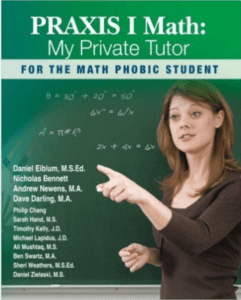
This is a review of the book “Praxis I Math: My Private Tutor for the Math Phobic Student.” A cursory inspection of this volume raised my suspicions. First of all, this is relatively expensive (~$35) for a single-subject Praxis Core guide (some books preparing you for all three subjects cost less!) The cover lists a whole slew of people with a bunch of letters after their names, mostly Master’s Degrees or JDs (i.e. a law degree). It’s not immediately obvious to me, a person with two decades of experience teaching math, how having a law degree would necessarily make anyone a better math teacher. More to the point, if someone has a Ph.D., then perhaps that’s impressive, at least in some cases, but if all folks have are masters degrees, there is something exceptionally pretentious about listing them after names on the cover. This seems like a cheap ploy to make it appear that the authors are exceptionally qualified to write this book. This immediately lit up all my poppycock alerts. But, putting these first impressions aside, let us give the content a good look.
The Math
It’s extremely clear that the authors know a lot of math. In some cases, they appear to have some knack for explaining at least some of it. Their knowledge of exactly what the Praxis Core Mathematics Test covers is considerably shakier.
The books purports to break all the math you need for the Praxis into bitesize chunks. In doing so, some “chunks” get short shrift: for example, there is much more I would like to say to a “math phobe” about fractions that this book simply didn’t cover in their abbreviated treatment. In some “chunks,” the treatment is adequate, and in some, the book covers material well beyond what you need for the Praxis Core Mathematics Test. For example, much of what was in the Geometry section was more appropriate to a high school Geometry class than to the Geometry question you will find on Praxis Math.
Some of the problems are ridiculously easy, which I realize would be confidence building, but students have to be told that such questions are not as hard as what they will see on the real test. Other practice problems are considerably harder than what would appear on the Praxis, and some of them have a difficulty and subject matter that is entirely out of scope. Several distinctive question types unique to Praxis simply don’t appear: for example, the problems with algorithmic flowcharts or the word problems about numerical calculations (see the Magoosh lessons on these specific types). The people who wrote this book have missed many of the features unique to the Praxis Core Mathematics Test.
Most of the questions are simply Multiple Choice. Some are asked in textbook style, with no answer choice given, so these could be considered Numeric Entry questions. There is almost no mention of Multiple Answer questions. Again, the authors of this book seem to have had different priorities than do the folks who write the Praxis Core Mathematics Test.
I find it particularly disturbing that this Praxis book markets itself to the “math phobe,” to the person who struggles with math and finds it difficult, and yet they cover all kinds of additional difficult material that is not relevant to the Praxis. As with many things about this book, that appears more as a gimmicky claim in their subtitle to boost sales, rather than an authentic pedagogical concern that informed every part of the book.
Summary
As you might gather, I have a dim view of this book on a number of levels. Some of the math could be helpful, but the book is tracked closely to neither the needs of a genuine “math phobe” nor to the specifics of the Praxis Core Mathematics Test. I would not recommend this book.
Grade: F
Learning Express Praxis Core Academic Skills for Educators
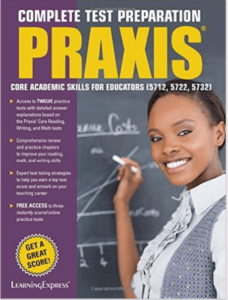
This is a review of the book Praxis Core Academic Skills for Educators by the company Learning Express (LE). Unlike some other Praxis guides, this book, published in 2014, is aware of the modern Core tests and the question formats on these tests. Chapter 1 contains a valuable overview of general information about the Praxis Core, including registering, cancelling scores, and retaking. Chapter 2 contains the “Learning Express Test Preparation System,” a nine-step organizational plan, including stress-management exercises and study schedules: I was impressed with this chapter. Chapter 3 contains a full practice test, all three subjects, to be used as a diagnostic. Chapters 4-6 go through the content in the three subject areas. Chapters 7-8 contain two full length practice test, each with all three subject areas. I will review the book by subject area.
LE on Reading
The 20 pages of Chapter 4 provides an intelligent and thoughtful overview of strategies on the Praxis Reading. This chapter succinctly covers several excellent points. I definitely would recommend these 20 pages to anyone trying to get a handle on Praxis Reading.
The passages on the practices tests have the length and subject range and feel of passages on the Praxis. My only criticism is that, on the first practice test in Ch. 7, one of the questions on the Reading Test looked like a Revision-in-Context question—more on this below. Overall, the questions on the practice Reading tests would provide good preparation for somebody studying for Praxis.
LE on Writing
I am more than a little puzzled by the parts of the book dealing with Writing. In the opening of the book, in Chapter 1, they clearly state the four kinds of questions on the Writing Test: Usage questions, Sentence Correction questions, Revisions in Context questions, and Research Skills questions. They state all four in Chapter 1, and then throughout the rest of the book, they ignore the latter two formats. Every practice Writing Test in the book has, for its 40 multiple choice questions, just 20 Usage questions and 20 Sentence Correction questions. The only Revisions-in-Content question I found in the entire book was including in one of the practice Reading sections! If a student were to use this book as her sole source of information, she would be woefully uninformed about the Revision in Content and Research Skills question formats.
Now, having said that, the Usage and Sentence Correction questions are good. Chapter 5 devotes about 15 pages to a brief but informative overview of grammar, and then the last eight pages are a good overview of strategy for the essays. This treatment of content is brief, but it’s a good introduction.
LE on Math
Chapter 6 devotes more than 60 pages to a math review. I would say that, here, the LE folks were concerns with efficiency, covering all the math factoids in an efficient manner. Toward this end, the treatment leans heavily to the algebraic and formulaic, neglecting what I would call the more intuitive side of math pedagogy, which, admittedly, is wordier and more time-consuming. It’s not immediately obvious to me that some who wants to learn all of math from Square One could absorb everything here. I would say this section is more valuable as a reference work, in which one might look up particular facts, rather than a text that one would read from beginning to end. I will also say that in some instances, such as probability and functions, this chapter goes into more deeper and more sophisticated material than I have seen on the Praxis Mathematics test.
The practice math questions on the three practice tests (Chapters 3 & 7 & 8) are a mixed bag. I will say, they lean a little more heavily on the Multiple Choice format, and have slightly fewer Multiple Answer and Numeric Entry questions, than did the Praxis online practice Mathematics Test. About half the questions are very much like Praxis math questions, and would provide excellent practice. The other half of the questions include many questions that are way too hard or focused on concepts about which the Praxis does not ask. Unfortunately, all these questions appear together on the practice tests, so this makes me reluctant to recommend taking the practice math tests in this book. How is the unsuspecting student to discern which questions are genuinely Praxis-like and which ones are out of scope? A student who doesn’t have a refined sense of exactly what would be or wouldn’t be on the Praxis Math might get all sorts of strange ideas from some of the math practice questions in this book.
Summary
It is hard to give an overall assessment of this book because some parts are very good, and others, I wouldn’t recommend.
Pros:
- Good introduction and strategy sections, Chapters 1-2
- A very good discussion of Reading strategies in Chapter 4
- Good practice Reading questions in the practice tests
- Good practice Usage & Sentence Correction questions in the practice Writing Tests
- The math chapter (Chapter 6) would serve well as a reference work
Cons:
- Both Chapter 5 and the practice tests ignore two Writing questions: the Revision-in-Context and Research Skills questions
- Some of the math in Chapter 6 is too advanced
- Only about half of the math questions on the practice tests are genuinely Praxis-like
I could definitely see buying this book to get specific things from it. If one is discerning about what one can and can’t use, one could derive a great deal of value from this book. On the other hand, a student would be at a severe disadvantage if she were to rely on this book as her sole source of preparation for the Praxis Core.
Grade: B–

